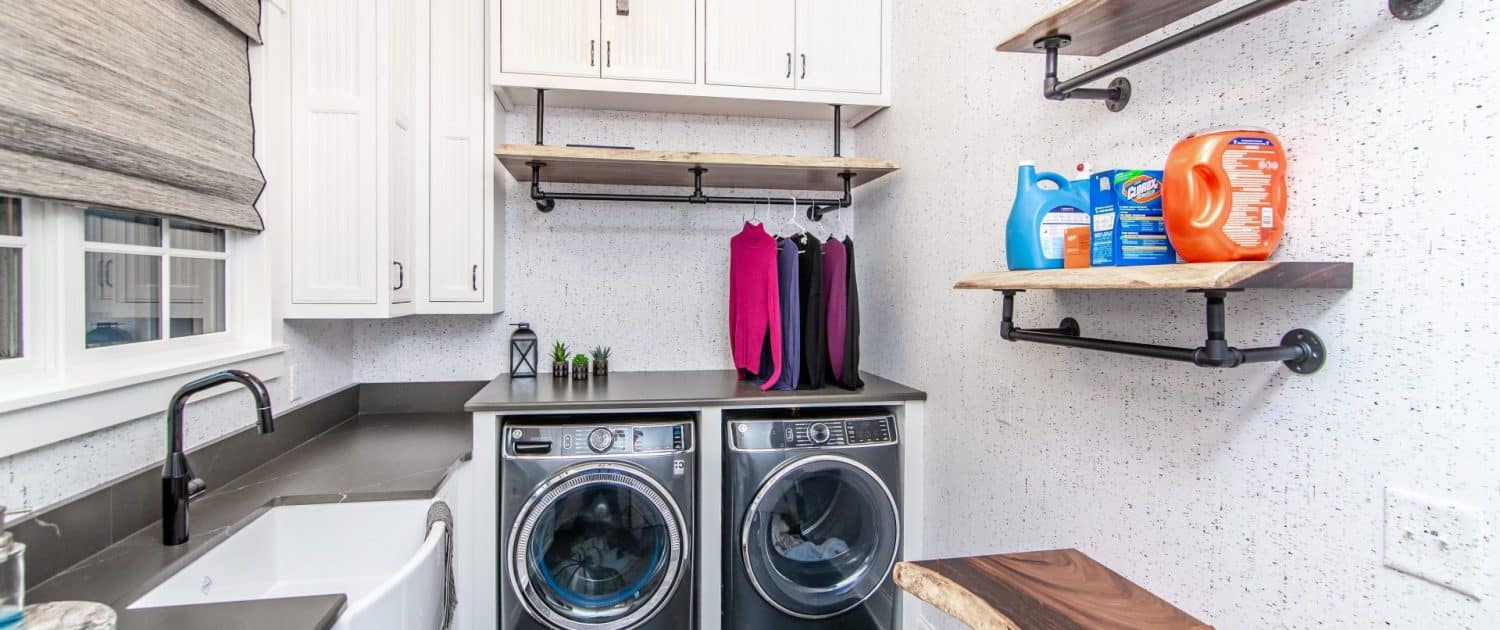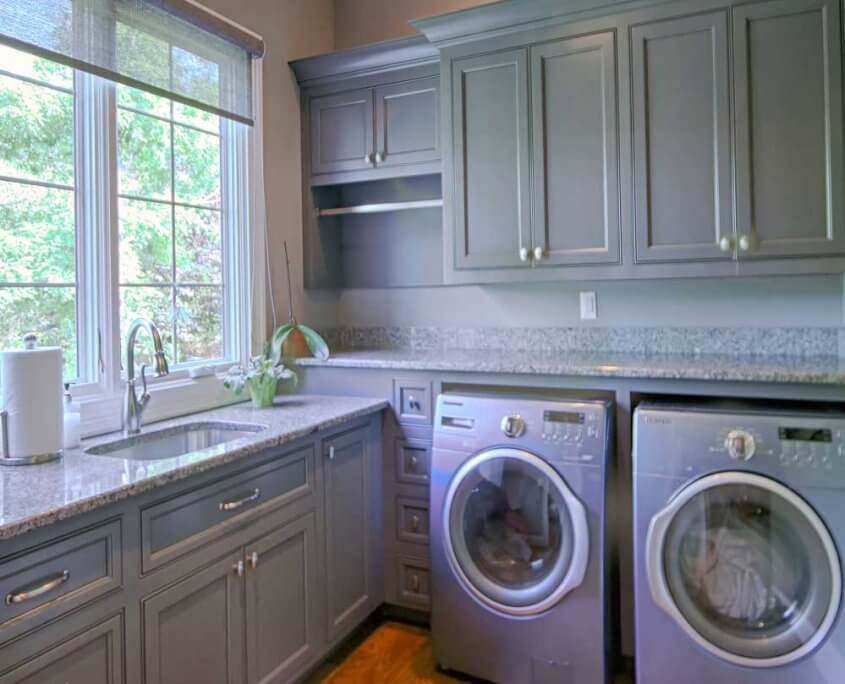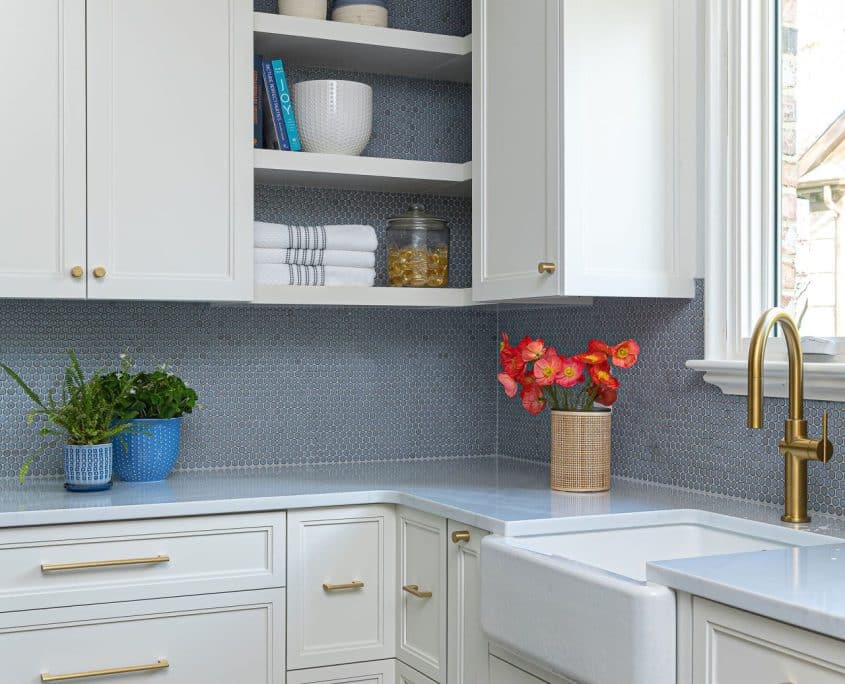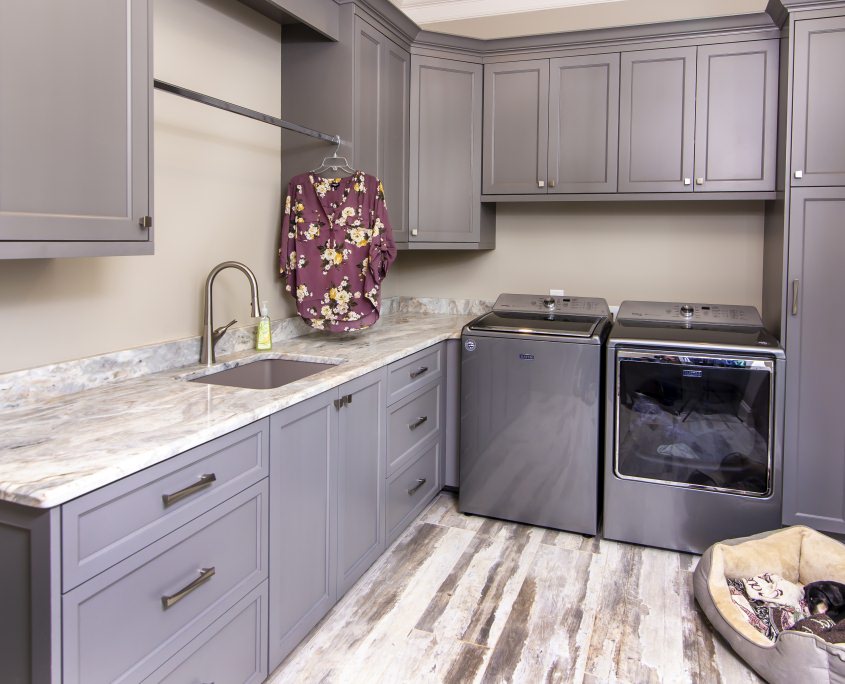 Post by Stacey Walker. Stacey mostly works behind the scenes for Walker Woodworking, managing day to day operations, and marketing. Stacey has helped many clients create their dream space.
Post by Stacey Walker. Stacey mostly works behind the scenes for Walker Woodworking, managing day to day operations, and marketing. Stacey has helped many clients create their dream space.
Laundry Room Design Tips
The laundry room is essential to the smooth operation of the household because it keeps garments tidy and ready for use. Given that the washing cycle never ends, it is obvious that long stretches of time will be spent in this area, so enough time should be spent designing it to be equally practical and pleasant. Finding ways to make the most of your available space, being aware of the crucial components to incorporate into the design, and simplifying the process will reduce frustration and save time.
How to design a laundry room layout
The location and flow of a space are just as important as the elements inside. Consider the tasks involved with doing the laundry so that you can structure it accordingly. Placing the laundry room upstairs is a great option if most of the bedrooms are located there. Creating a specific spot to store detergent and dryer sheets near the appliances keeps them within easy reach. Adding a countertop to the laundry room provides you with the perfect space to fold your clothes right away instead of on the couch or in each individual bedroom. Take time to go through each task so your design can be customized to your needs.
Laundry design with front loader
A front-loading washer and dryer have doors facing the front, which tends to offer easier access when doing the laundry. There are several ways to make the most of storage when designing for a front loader, such as placing it on a pedestal with built-in drawers. If the appliances are placed side by side, you can take advantage of the wall space above by either adding a full wall of upper cabinets or shelves. Stacking the front-loading machines frees up space for cabinets to be installed that go from floor to ceiling. Opting for custom cabinets can provide tailored made solutions that guarantee every inch of space is used to the fullest.
Laundry design ideas
One of the main goals in design is to create a space that is functional, and this is especially true with the laundry room, but no one said it had to be boring. Including elements, such as color and pattern, can brighten up the space and highlight a touch of your personality. Tile or backsplash can be a wonderful way to do this, and because it is water-repellent, it is also a practical choice. Opting for a bold cabinet color is a great choice, especially when paired with a neutral wall and flooring palette. Don’t be afraid to include a little bit of style in this functional space.
How to design a laundry room for small spaces
It is always important to maximize space in the home but it becomes a top priority when working with less square footage. For a small laundry room, study the available space and look for ways you could utilize it to the fullest, such as wall space. Installing a wall of cabinets, even if they are not as deep as the standard size, will provide you with ample storage for detergent, cleaning supplies, and other items. Shelves are another ideal design tool, plus they can be used to add a little style to the laundry room. Minimizing clutter is crucial throughout the home, but in a confined area like the laundry room, it is essential, so be sure to only keep what is needed.
Laundry room storage
When building a laundry room, storage is a crucial component that should be carefully considered. The finest storage options are cabinets since they can accommodate a wide range of items and sizes while remaining out of sight. Cabinets also make it easier to stay organized by separating items, such as detergents, cleaning supplies, and even paper products. Built-ins provide storage for a laundry room since they offer storage, but to add style you can use woven baskets or bins covered in fabric to add a little color to the space.
Laundry room design mistakes
Deciding where to place the laundry room is an important part of the design, but being open to several options can help ensure that the best spot is selected. Though you may want it in the basement because it is out of the way, if most of the laundry comes from the second floor, it might make more sense to place it there. If there is an extra foot of space next to the washer and dryer, see if there is something that can go there like a narrow roll-out. Lighting is critical in task-heavy areas like the laundry room, so be sure to incorporate particular resources, such as LED strips under cabinets and overhead lighting.
Laundry design must-haves
Some features are forgotten when building a laundry room due to financial constraints or because they can be updated later. However, some characteristics, such as:
- Drying rack: this provides a place for delicates as well as other clothing items that cannot go in the dryer to hang up versus scattered around the house blocking doorways.
- Folding stations: instead of having to carry each load of laundry to another room of the house, usually a bed or couch, to fold, having a designated area that is waist-high makes it easy to get it all done in one spot. Not to mention helps the backaches!
- Sink: Including this component in the layout of the laundry room makes it simple to soak or pre-scrub a difficult stain before washing it.
Adding these features to the laundry room can help make the repetitive task a bit more enjoyable.
Laundry mudroom design ideas
Sometimes a space needs to serve multiple purposes, and places like the laundry and mudroom are great combinations that complement each other. While there are a few variations in each of the spaces, there are also several common threads that make it easy to blend them together. Mudrooms are designed to be a designated areas for the family to take off outerwear like coats, hats, and shoes so that dragging dirt into the house is limited. Laundry rooms are the place where clothes are washed and dried. The main goal is to craft an area where the two can operate seamlessly. Placing them across from each other or side by side creates defined boundaries for each. Adding a hamper for dirty clothes helps eliminate the chance of dirt making its way onto clean clothes as well. Including a sink is a good choice since it allows everyone to immediately wash their hands or wipe down any other messes, such as the dog’s muddy paws. With this pleasing combination, you can have an organized place to do the laundry plus an area for the family to shed those dirty clothes right away.
Designing a laundry room
Every laundry room should aim to choose the components that produce a functional workspace. It will be customized to meet your unique demands, resulting in less time wasted and more time for your favorite activities. With the help of your designer, create the ideal laundry room for your household.








